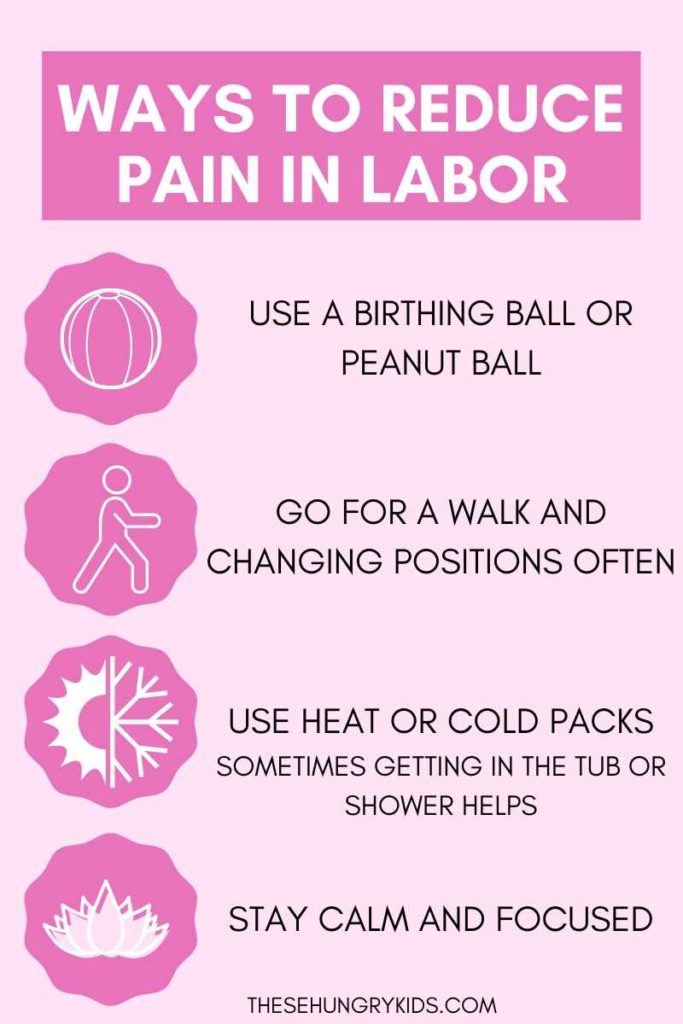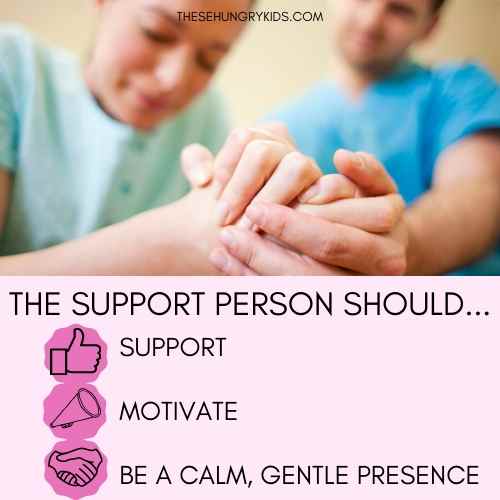It’s impossible to imagine what labor feels like. And anticipating pain in labor is stressful for many people.
I can totally understand! It’s hard to think about, and unless you’ve experienced it, you can’t fathom the entire experience.
Giving birth is complicated! You’ll feel many things during your delivery. Excitement to meet your baby, fear of the unknown, joy when the baby is born, anxiety during contractions…it’s a rollercoaster of emotions!
Have an idea for how you’d like your delivery to go, but understand that things may change in the moment!
There is no “right” or “wrong” way to give birth – pain medications, epidural, or unmedicated are all perfect as long as everyone is safe and healthy.
The goal of labor and delivery is always that everyone is alive and well at the end of the day.
Many women wish to conquer labor without the use of pain medication! Either way you decide to go, the tools and information on this post will be useful for any phase of labor, and with or without pain medications.
There are many ways to alleviate pain in labor, but there is really no way to get rid of the pain entirely without medications (and any post you read that tells you otherwise is a lie…). And to be totally honest, most people still experience discomfort and pain in labor even with medications or epidurals.
Bookmark this page, share it to Facebook, email, tweet, pin it, send it to your friends…whatever you fancy! You and your partner will want to reference it when labor begins!
My mission is to prepare and inform, not advise. There is no place for shame or guilt in labor – you are entitled to give birth however you see fit. Pain meds, no pain meds, vaginal or c-section, you rock it, mama!!The information in this post is purely for entertainment and is not meant to replace the advice of a medical professional. I always adhere to HIPPAA policies, any similarities to yours or anyone else’s story is purely coincidental. Please see my disclosure policy for more information. This post contains affiliate links, meaning I may earn a small commission at no additional cost to you if a purchase is made using the links. This helps fund this site, and keeps These Hungry Kids up and running. Thank you!
You may also be interested in THIS POST, where I compare my birth with an epidural to my birth without pain medications.
Be Prepared and Do Your Research!
There are many ways to help alleviate the discomfort of labor, but there is no way to truly know what will work for you until you are in labor yourself!
The best thing you can do is prepare, prepare, prepare.
This means you are gathering all of the items you think might help alleviate pain in a separate, easy to access bag. Make sure your support person knows where to find it and what’s in it.
Prepare for labor with the following things:
- A dedicated support person who knows your wishes (this may be your partner, doula or family member)
- An idea for which pain management techniques you’d like to try, and any tools you think you may need to get through labor, such as:
- A playlist of music you may find relaxing
- A diffuser and aromatherapy oils
- A birthing ball
- A massager or tennis ball
- Distractions for early labor, such as games, puzzles, Netflix, books, etc.
- Be knowledgeable of the resources available, should you choose to want pain medications. Each hospital, midwife and obstetrician varies slightly on what is available and how quickly you can receive pain medications if you decide you want them.
- For example: in some cases the anesthesiologist may need to be called in for you to receive an epidural, whereas some hospitals have them available at all times.
Communicate Your Needs During Labor
Always communicate your desires with your nurse, doctor and anyone else on your medical team. They want to support you and help you!
You should all function as a team. If you don’t feel that your doctor is on the same page as you, you can switch providers (ideally before the third trimester).
Your nurse will ask you what your pain level is frequently. Some women feel that this makes them dwell on their pain level, and request not to be asked about their pain level in labor. This is totally up to you — sometimes it’s therapeutic to communicate your discomfort.
My biggest advice for anyone going into labor is: go in with an OPEN MIND! Anything can happen, and you may find yourself changing your mind on what you thought you wanted or needed in labor. That’s OK.
If the techniques you’re trying aren’t working, try something new!
Tips for Pain Management in Labor
If you can, labor at home as long as possible
There is nothing like the comfort of your own home. Discuss with your providers when you should head to the hospital or birthing center, but stay at home until you are unable to if possible!
Breathing techniques
There have been many studies regarding whether breathing techniques are effective, and this article from Evidence Based Birth outlines them all.
To summarize the article, breathing techniques alone do not greatly alleviate pain, but when used with other methods of relaxation (such as guided imagery, hypnosis, etc), patients reported higher levels of pain relief.
From my experience as a labor nurse, I find that having women focus on their breathing tends to help them focus on something other than contraction pain.
Does it get rid of the pain? No. But it can be relaxing, and is something to think about other than pain.
The old Lamaze way of thinking about breathing techniques (slow breaths in early labor, huffy breaths in active labor) is a bit outdated, and hasn’t been proven to be effective.
Frequent position changes
This can help speed labor along by allowing baby to wiggle into the perfect position for delivery. It also helps keep muscles, joints and ligaments loose and relaxed. It’s easy to become tense in labor.
Some suggestions for positions to try include:
- Change from side to side frequently when lying in bed
- Squatting
- Kneeling
- Sitting
- Rocking in a rocking chair
- Leaning against your partner, the bed, a table, a wall, etc.
- Swaying side to side with each contraction
- Hands and knees
- Put one foot up on a stool or chair, either directly in front of you or off to the side. Be sure to switch legs every few contractions
Take a Shower or Bath

See if you can labor in the shower or tub for awhile. Letting the water run down your back or belly can be relaxing and offer pain relief.
Many birthing centers or hospitals have tubs that you can soak in. This helps to relax the muscles and allows for some pain relief.
NOTE: If you are in the hospital and they want to continuously monitor the baby, ask if they have waterproof monitors. Many facilities will allow you to soak in the tub with special monitors!
Even if you don’t desire a water birth, tubs and showers can provide fantastic pain relief.

Aromatherapy
This was the last thing I wanted in my labors, but it is useful for many. I felt like I could smell everything my husband had eaten for the last 24 hours on his breath, and I am nauseous when I’m in pain.
For many, aromatherapy helps to calm and send zen vibes. Load your diffuser with an essential oil blend that helps to relax you (I see chamomile, peppermint, and lavender used a lot), but I recommend keeping it subtle, as many women experience nausea and vomiting while in labor.
Use of hot/cold packs
Heat may be useful in early labor, whether across the lower back or belly. You can use a hot pack, or my personal favorite, this.
I also used this particular heating pad a lot with breastfeeding. I tend to get tense neck and shoulders from the way I sit when breastfeeding, so it’s been a lifesaver!
When I would cramp a lot at home in late pregnancy, I’d warm it slightly and lay it across my lower belly. Plus, it smells really nice, is super soft, and is easy to heat up in the microwave! My husband bought it for me last Christmas and I use it all the time.
Cold washcloths may be useful in active labor, often across the chest, forehead, or neck.
Counterpressure
This is especially helpful when the contractions feel worse on your back, hips, or tailbone.
Having your partner or support person push and massage your lower back can be helpful in relieving the pain.
You may wish to bring a tennis ball or hand massager for this.
Birthing balls
It’s no secret how much I love birthing balls.
I labored on them with both my babies, and sat on it frequently during my final trimester.
As a labor nurse, I find them super helpful in opening the pelvis to make room for the baby and providing pain relief on the lower back and hips.
There are MANY ways to use a birthing ball, but here are a few suggestions for positions to try during labor:
- Sitting on it and leaning against the bed or wall. You can sway your hips rhythmically through a contraction.
- Kneeling on the ground with your upper body draped over the ball
- Putting the ball between you and the wall and massaging your back against it.
As you may have read in my post here, I specifically recommend The Birth Ball brand, as their balls are designed for laboring patients. It comes with a handy book of ways to use the ball before, during, and after pregnancy and with it’s own portable pump so you can inflate and deflate the ball to your preference.
Note: Your hospital may have birthing balls for your use in labor, but you should call and ask if there is enough for every patient and if there is a variety of sizes to choose from. There may not be one available for your use if there are only a few for the entire labor floor.

Distraction
TV, movies, books, puzzles, games, visitors, etc. are all great ways to distract from the discomfort. If you are being induced, these are crucial, as inductions can sometimes take a few days!
Distraction is a useful tool for early labor, but not as helpful in active labor when you may need to buckle down and focus through contractions.
Music
Calm, soothing music can help set the mood of the room and can help keep you relaxed.
Avoid music that is loud and abrasive, as you may find it increases your level of anxiety.
Hypnosis, or hypnobirthing
Hypnobirthing is a technique that combines breathing techniques, relaxation techniques and guided visualization
There are many courses on hypnobirthing to prepare you for labor. They aim to alleviate fears and anxiety associated with labor and help to teach relaxation to alleviate pain.
I have seen a few patients have successful unmedicated deliveries using hypnobirthing techniques, but it’s not for everyone. You should practice the techniques at home first to see if you find them helpful and calming.
Guided Imagery
If you’ve ever been to a yoga or meditation class where the instructor coaches you through visualizing your muscles relaxing, your tension releasing, etc. in a soothing voice, that is a form of guided imagery.
Guided imagery uses your imagination to assist with pain relief through distraction and relaxation.
A support person is great to help with guided imagery. They can be that soothing tone that reminds you of the images you’d like to focus on.
You may wish to visualize some of your favorite places, a favorite time of your life, your muscles relaxing, your cervix opening, etc.
- Example 1: “Imagine each breath flowing through your body. Take a deep breath in, and when you exhale, imagine that breath traveling to your baby, guiding him/her through your body. With each breath, you are nourishing your baby and sending him/her on the right passage…”
- Example 2: “Imagine you are on a beach. You can feel the sand between your tones. It’s warm, and you can feel a slight breeze in the air. You hear the waves crashing against the shore, and you can smell the salty water…

You may also be interested in: 7 Myths about Epidurals and After Baby is Born: What to Expect and How to Prepare.
Familiarize Yourself With the Birth Center or Hospital
Most hospitals and birthing centers offer tours and classes you can take to become familiar with the environment where you will give birth. This is a great time to ask any questions you have regarding the entire process, start to finish.
Some questions you may want to ask are:
- Will birthing balls be provided, or should I bring my own?
- How many are available for the floor?
- Are there different sizes to choose from?
- Are tubs and/or showers available in every room?
- How do I go about requesting a room with a tub or shower?
- Will the baby require continuous heart rate monitors?
- Are wireless heart rate monitors available so I am free to walk and move about?
- How do I go about requesting a wireless monitor?
- Does the hospital provide hot and cold packs?
- Are there any policies that would not allow an essential oil diffuser in the labor room?
- How many support people are allowed to be in the room with me?
- How many people will be present at delivery?
Hot read: Labor like a Pro: how to rock your labor!
Have a Strong Support Person (or two!)
A Strong Support Person is a Necessity.
You need someone in your corner who is going to be supportive, calm, and reassuring.
Now, my husband is amazing in so many ways, but he is not too fond of the medical stuff, and I was afraid he’d panic if it was just him alone supporting me through birth.
With both of my deliveries, I invited my mom to be in the room. She is a former labor and delivery nurse and my best friend – so I knew she would know exactly how to support me during my delivery!
As a team, my husband and mom were amazing. They kept each other and me calm and I felt like I had amazing support.
Tips for the support person…

Labor is intense. The pain is a lot and it’s very exhausting! It can be hard to watch the person you love and care for in such extreme discomfort.
Check out this post, where I tell you exactly what you need to do when your loved one is in labor!
Remember: childbirth is natural. The pain is normal (though it seems like it can’t be!)
Your medical team will let you know if there are concerns and reason for alarm.
Your job is to be super supportive, reassuring, and level-headed. Offer a hand to squeeze, sips of water, undying support, and remember: the laboring woman can say some nasty things…shake it off and stay with her.
You may be asked to lead guided imagery, assist with position changes, apply counterpressure, hold her hand, and say things like:
- You are doing great.
- This is normal.
- You are so brave.
- Each contraction is one step closer to meeting the baby.
- You are safe.
After the baby is born, if mom chooses to breastfeed, your job is to be her hands and (continue) to be reassuring. You can read all about breastfeeding here, but know that there is a big learning curve and it can take awhile to get the hang of it.
If mom chooses to formula feed, you can help by feeding the baby or getting the bottle ready for her. Her body has been through a lot, and the support should continue beyond the labor room.
Additionally, you should be helping to meet the baby’s basic needs of diaper changes and comfort. Allow mom to get some rest, and feel like the burden of motherhood isn’t only on her shoulders.
Take the time to rejoice in your infant, help with the difficult things, and provide her comfort as she adjusts to her new role as mom.
For no frills, no bullsh*t, honest post about what to expect when returning home with baby, check out this post.
The thought of being in pain is a big source of anxiety for many expecting moms! Be armed with knowledge, and try out some of these techniques at home to see which techniques suit you best.
Remember: anything can change in any given moment in labor. Sometimes the baby calls the shots and things don’t go as planned.
Trust your body, and find a team that you can trust as well! It’s this strong patient-provider relationship that creates a safe environment where everyone’s needs are met.
You can do this, mama!



Pingback: Labor Epidurals: The Facts and Myths Debunked (2022) | BirthSmarts